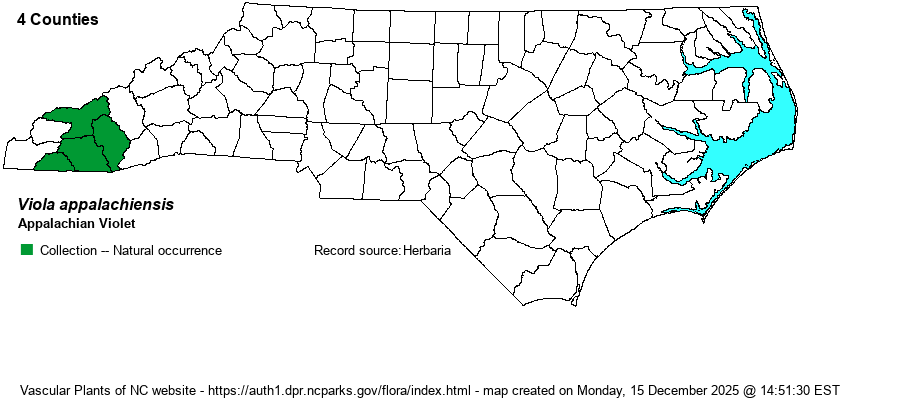| Author | L.K. Henry | |
| Distribution | This species, part of V. walteri in RAB (1968), is limited in the state only to the southwestern Mountains, where known from just four counties -- Clay, Jackson, Macon, and Swain.
This is a central and southern Appalachian species, ranging from PA and WV south to southwestern NC. Oddly, it seems not yet recorded from VA or TN.
| |
| Abundance | Rare within its small range, though the NCNHP database lists 22 records from this fairly small area. This is a Significantly Rare species. | |
| Habitat | This species requires high pH soils, though it can be found in both dry and moist/rich situations. It grows in rich cove forests, floodplain forests, as well as in drier serpentine barrens, often near seepage. |
| Phenology | Blooms in April and May, and fruits shortly after flowering. | |
| Identification | This species and V. walteri are odd violets, as they are creeping or trailing and not erect. Each is a bit mat-forming, rooting at nodes. Each has quite rounded leaf blades, with cordate bases. This species has essentially glabrous leaf blades, which are evenly green above; V. walteri has noticeably densely pubescent leaf blades, and they are gray-green to pale green except for the darker green veins. The flowers are standard ones for the genus, being violet-blue in color. You should note that it can be somewhat difficult to tell if a plant is crawling along the ground, as compared with other species that do not yet do grow in fairly dense clusters. The quite rounded leaves at the apex, about as wide as long, might be the first clue you have this unusual species. If in doubt, pull on a leaf or stem to see if the stem is indeed creeping and rooted at the nodes. | |
| Taxonomic Comments | Until recently, this species was included within V. walteri. Some references name it as V. walteri var. appalachiensis.
General note on Viola: In 2009-10 B.A. Sorrie (website map editor) went through the whole collection at NCU, annotating all specimens against those verified by experts in the genus. The range maps in RAB (1968) have been changed accordingly. More recently, Harvey Ballard and colleagues are in the process of revising all Eastern and Southeastern Viola, and have annotated all specimens at NCU in July 2024. They recognize additional species not in RAB or in previous editions of Weakley et al.; we will follow updated editions of Weakley et al. in recognizing them. Species range maps have been adjusted to account for identification changes. | |
| Other Common Name(s) | Appalachian Blue Violet | |
| State Rank | S2 | |
| Global Rank | G4 | |
| State Status | SR-T | |
| US Status | | |
| USACE-agcp | | |
| USACE-emp | | |

